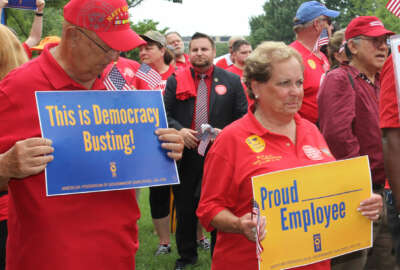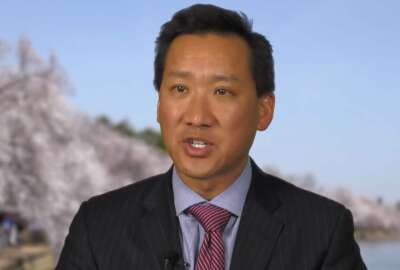
Why collective bargaining just got more complicated for some VA employees
A recent decision from Veterans Affairs Secretary Robert Wilkie adds more complexity to collective bargaining procedures for certain VA employees.
Best listening experience is on Chrome, Firefox or Safari. Subscribe to Federal Drive’s daily audio interviews on Apple Podcasts or PodcastOne.
Collective bargaining at the Veterans Affairs Department just got slightly more complex.
VA Secretary Robert Wilkie has rescinded a previously agreed-to memorandum of understanding that let federal unions use the collective bargaining process to grieve instances where the department didn’t follow its own policies or procedures related to employee conduct, compensation and other circumstances.
The agency said the decision signals an attempt to “refocus” VA’s commitment to patient care.
“President Trump has made it clear that we want our providers laser-focused on caring for veterans, and that’s exactly what we’re doing here,” Wilkie said late Friday afternoon in a statement. “This move today ensures that unions can’t bargain on issues related to our providers’ professional conduct or competence, essentially patient care.”
Wilkie’s recent change doesn’t apply to everyone. But it will likely have an impact on doctors, nurses, dentists and other clinical practitioners who fall under Title 38 of federal statute.
The Federal Labor-Management Relations Statute generally describes what labor unions can and can’t bargain over, but it does grant an exception. A specific provision within Title 38 leaves it up to the secretary to determine whether federal unions can bargain over issues of professional conduct or competence, peer review or employee compensation for certain federal employees.
VA in 2010 signed a memorandum of understanding with the American Federation of Government Employees, National Nurses United, Service Employees International Union and National Federation of Federal Employees. The memo generally set procedures and guidelines for VA and its labor unions on matters of professional conduct, peer review and compensation. Specifically, it gave federal unions the green light to grieve on behalf of an employee at the Veterans Health Administration in situations where the department failed to follow one of its own policies or procedures on compensation, peer review or conduct.
It’s a circumstance that happens more frequently than you might imagine, said Ibidun Roberts, supervisory attorney for AFGE’s National VA Council.
“Doctors have limitations on how many hours they can work in a day,” she said. “Say their management made them work beyond that time and they wanted to grieve that and say, ‘Hey, we have policy that [says] I’m not supposed to work that long.’ What this rescission is doing is saying the secretary no longer consents to an employee grieving that.”
VA keeps specific policies on overtime and night differential. In times of emergency, the agency may forego the policy, so VA doctors and nurses can work extra hours. This happened during last year’s hurricane season, for example, when VA medical staff slept in their offices to continue scheduled shifts and fill in for their co-workers who couldn’t make it to work.
After the fact, AFGE filed a grievance to help VA medical staff earn back pay, Roberts said.
“The VA worked with us to correct it,” she said. “Those people got their leave corrected. They got their pay corrected after that. They worked with us to do that. With the rescinding of this document, that kind of resolution would not happen.”
AFGE first learned of VA’s decision to limit collective bargaining in these circumstances on Friday afternoon when the department announced the recent clarification in a press release, but Roberts said it wasn’t a major surprise.
“This isn’t in our contract, so this isn’t a huge shock,” Roberts said of VA’s decision to rescind the prior memo of understanding. “It goes in line with what we’ve been seeing with the VA recently.”
Roberts said AFGE is exploring what options it might have for recourse, but she wouldn’t describe what possible actions the union is considering.
VA’s most recent decision is complex, but it makes one thing clear: the department and its union representatives are not talking or collaborating.
VA’s most recent announcement follows a separate announcement the department made in mid-July, which detailed how the agency plans to implement the president’s recent executive order on official time. The VA guidance described the agency’s expectations for union representatives to limit official time to no more than 25 percent of their working hours.
AFGE, however, has filed a grievance with the department over what it said has been a “chaotic” implementation of the president’s official time EO.
Roberts said VA has until Sept. 22 to respond to AFGE’s grievance, according to a provision in the agency’s contract with the union.
“We have not heard from them,” she said. “They are supposed to communicate with us in an attempt to resolve the grievance, but we have not heard from them yet.”
About 1,700 VA employees used official time in some capacity. By VA’s count, two doctors, 65 nurses and 405 other agency employees spent 100 percent of their work hours on official time.
Roberts said AFGE hasn’t yet received word from VA about how it expects it will implement the president’s executive order on collective bargaining, which encouraged agencies to begin charging federal unions rent or ask that they vacate federal property and turn over government-issued equipment.
Other agencies, such as the Social Security Administration and Housing and Urban Development Department, have already told union representatives to leave federal property.
VA told Federal News Radio earlier this month that it was implementing the president’s collective bargaining EO through its regular collective bargaining agreement negotiation process and had not issued specific guidance to federal unions about office space.
Copyright © 2025 Federal News Network. All rights reserved. This website is not intended for users located within the European Economic Area.
Nicole Ogrysko is a reporter for Federal News Network focusing on the federal workforce and federal pay and benefits.
Follow @nogryskoWFED
Related Stories

Judge hears oral arguments in unions’ legal challenge of Trump’s executive orders





